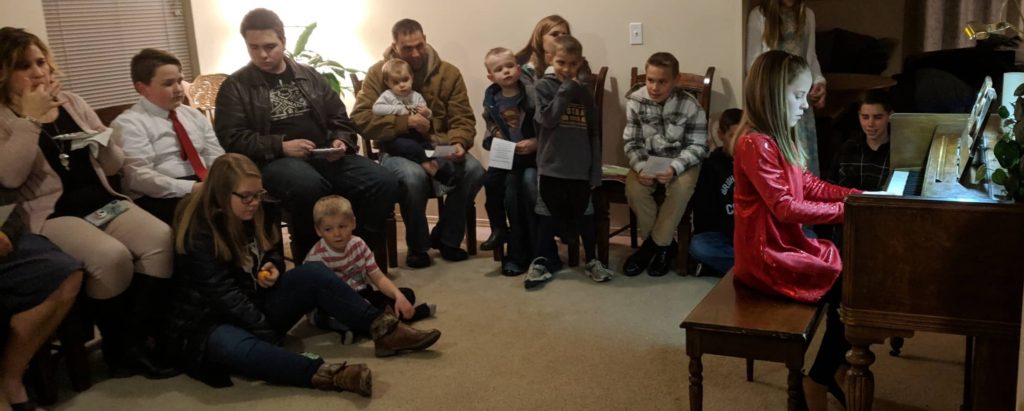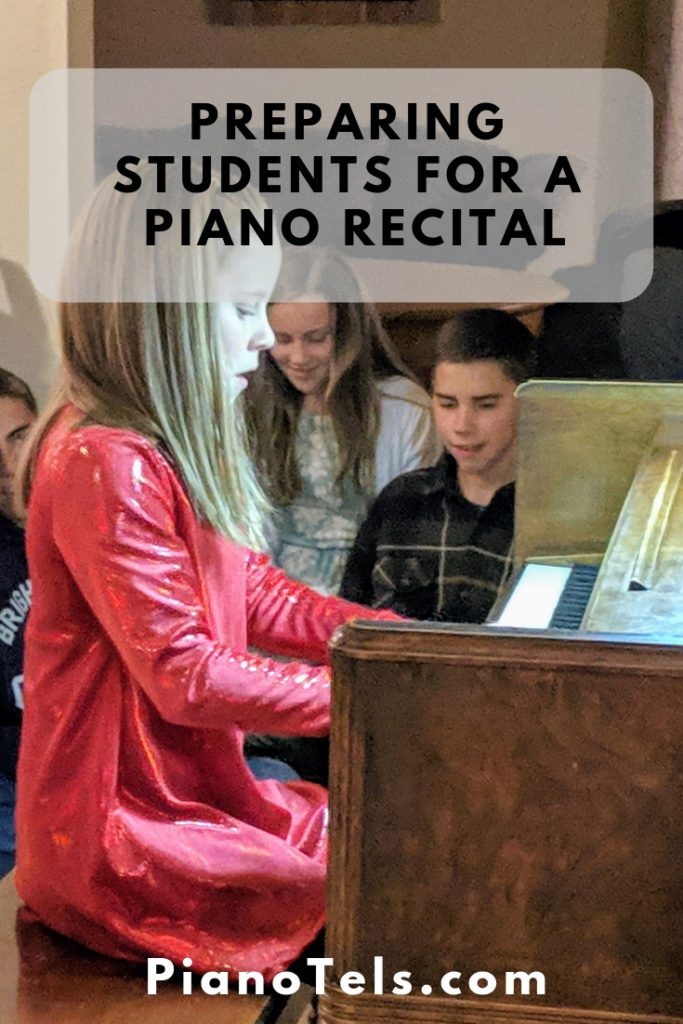Have you or someone you know had a terrible performance and still have terrible thoughts and experiences they remember from it? I had several performances that were just terrible growing up and I still shudder to think about those times. As I have studied about how to prepare my own students for recitals, I have realized that my own bad experiences were because I was not trained and prepared properly for the performance!
Preparing students for a piano recital means that they know the music so thoroughly, that their performance will be flawless. Learning the music and reviewing it in many different techniques can test the brain for true knowledge and skills in the music, and can lead to a confident performer.
In order to learn the music thoroughly, we need to train the brain so that anybody can have a positive experience during their performance. And as their teachers, we can provide all that they need so that their recitals and performances will be times they remember with pride!
Why thoroughly knowing the music will guarantee a successful recital.
Playing the piano is all about the brain. You simply cannot play the piano without the brain being engaged. Since our brains are absolutely amazing and by far the best asset we have to learning, playing, and performing on the piano, then we need to use it to our best advantage.
So while a performer may think they remember everything about the music in order to perform it, when different stimuli is presented at a performance (such as a crying baby, a stifled yawn, or a door opening or shutting), it can distract the performer and cause them to forget, or stumble over their music.
Since there are so many different and new stimuli at performances, we need to know the music so thoroughly that whatever is thrown at the performer, they can easily process that stimuli and continue flawlessly through the performance because they can play this song in their sleep — and they probably do!
How to come to know your music thoroughly.
One of the best ways to know your music inside and out and is to memorize it from the first time you play it. As you memorize it when you learn it, you come to know the music in depth. Memorize the music hands separate so that if the left hand stumbles, the right hand will know how to continue going.
If we know we have a recital coming up and when we are choosing our recital piece, have the students memorize it from the first time they begin to play it. Memorizing means more than just muscle memory, so make sure they have it memorized at least in these 3 ways:
- Memorize the song in chunks. Break the song into meaningful segments and memorize them by segments.
- Memorize hands separate. The left hand needs to play the song independently from the right hand. This is so that if one hand forgets its parts, the other hand can continue until the other hand can join back in.
- Memorize the songs hands together. Understanding the relationship of each hand to each other is also important. Think of it as the hands “speaking” to each other.
You will know if the student has thoroughly come to know the song if they can play the song from anywhere throughout the song.
Being able to play the song in your head is an important aspect of knowing the music thoroughly. Test your students on the notes on the page and see if they can either tell you the notes, or have them draw out the music on paper.
Being able to see the music (the staff — not the keyboard) in your head will really solidify their knowledge and memory of the piece. Being able to see the music in your head and playing it in your head is an incredibly helpful skill in memorizing and in performing! Teach your students these skills to ensure their success!
Are they really ready for the big day?
When recital time is near, I want to make sure that the students truly are ready for it. Knowing and understanding the music thoroughly will be aided as they memorize the music.
Everything we see, read, touch, or taste gets logged into the brain. The brain never forgets! Whether we like it or not, the information we take in from our senses gets logged away somewhere. So if that’s the case, then why is it so hard to remember things? Because although our brain never forgets, it is accessing that information that becomes the difficulty.
Thus, our goal is to create as many connections with the music as we can to ensure that the students have as many bridges in the brain as possible that will help them access their memory of the music. It gives them huge boost up to have as many bridges as possible built between the music and their brain so that there are multiple ways to grab the information that is stored in there.
The following activity helps build some of those “brain bridges”:
- The first thing I want to do when the big day is approaching, is to ask my students to create their own listening map of their recital piece. This helps them to create meaning and organization to the music in a new, fresh way — yet another way to remember and know the music. Their listening map can be detailed, symbolic, or just put as simple pictures. This also helps in engaging other senses, therefore building more bridges!
- When they complete their listening maps, I have them identify what their listening map means in relation to the music itself.
- Next, have the students play the recital piece, and as they play, have them describe where they are at on their listening map. As the teacher, follow along on the listening map and the sheet music.
- Encourage the student to play their song in their head as often as possible between now and the performance. They can imagine the staff, the sounds of the music, and the listening map they created for themselves.
Since all of our mistakes in the piano originate in the brain, (see Chaun C. Chang’s article for an excellent resource for additional information on this) encouraging the students to play the music mentally really helps them to prepare.
Prepare the student to know what to expect.
Once again, we are working on building bridges. So walk through with the student exactly what to expect the day of the performance. Describe in detail what the venue will look like, how many people will be there, what the chairs will feel like, and what noises they will hear.
If we can prepare the brain for the stimuli to come, it will be less for the brain to become overwhelmed with and they can cope with it better. Help the student to visualize, as much as possible, what to expect the day of the performance so that their brain won’t be as occupied by taking it all in as much as performing the music itself.
Record the student.
It is definitely an excellent practice to record the student before a recital. If possible, make a big deal about filming them on your camera. Doing this will “simulate” the experience of performance by putting a little stress on the brain.
When you are completed, make sure you evaluate with your student what that experience was like. Were they surprised by anything? Did they feel like they performed as well as they thought they would?
Often times, students feel like they do better than they actually do, because they forget to listen to themselves and forgive themselves of mistakes much easier than when in public. Filming them is like showing them what they are actually playing.
After you record them, talk about it with them first, and then have them watch themselves and critique themselves and their performance. They can use this valuable knowledge to polish up their piece before the recital.
Play slowly.
One other handy technique to ensure that the student knows their music thoroughly is to play the song slowly. As they play slowly, their brain is allowed to think through each key and they find the parts of the music they don’t know as thoroughly. If you have time, have them play their piece slowly to you so that both you and they can evaluate their weaknesses and brain vulnerabilities.
The best way to nail it on the day of the recital.
You definitely want to teach your students how best to nail the performance the day of. There are a few tips and tricks that all piano students need to know to be ready for the big day!
- The week of the performance, do not learn any new music so that you don’t confuse the brain.
- The day of the performance, do not overpractice! Your best time playing the piece is about the 3rd time you play it in a day. So save that 3rd time for the recital! (*Note: make sure that you tell parents about this otherwise they may be having their students practice too much the day of!)
- The day of the performance, only play the song through at normal speed once, then play it slowly one more time. Then no more physical practicing before you perform. (This strategy comes from Chau C. Chang)
- Stay hydrated because the brain works optimally when it is well hydrated.
- Wear comfortable clothing. Of course students need to wear appropriate attire for the performance (formal if required) but make sure that they aren’t distracted by what they are wearing.
- Have a dress rehearsal. If possible, have a dress rehearsal where the students can dress in their appropriate attire, come to the venue, and practice on the piano they will be performing. This will greatly reduce the stress on the brain as all these experiences won’t be entirely new the day of the performance.

Teach your students what to do if they do mess up.
You want to give the student all the tools necessary to be ready — and there are occasions when they do mess up. Teach them that there are ways to keep the mistakes to themselves so that the audience will never know! Give them these tips and tricks in case they need it:
- Do not react to mess-ups. No shaking the head, no words or sounds from the mouth.
- Play slightly faster and louder. Sometimes the brain slips in memory and in order to regain the lost info, playing slightly faster and louder will help the brain catch up to its spot again.
- Just keep going! Whatever happens, they shouldn’t stop in the middle of the performance! Have them continue to play — whether they can adlib until it comes again, or jump ahead to a new place in the song, or play one handed till the other can catch up. Just keep going, don’t quit!
- Imagine the music in your head as you play. Have them imagine the music and read it in their head! Accuracy is way better when they can do this.
Make it a positive experience.
The day of the recital needs to be as positive an experience as possible. We need to instill in them confidence and allow them to enjoy the fruits of their labor. Hopefully with all that you have done and worked through with them, they are confident and together, the bridges in the brain are enough to combat any additional stress or stimuli that occur that day.
Your students will be listening closely to what you or others say about their performance afterwards. They will want to know what the audience experienced and how they reacted to their piece. Make sure you acknowledge their work and give them the constructive feedback they are looking for! No need to dishonest, but surely they deserve praise for putting themselves up there through the performance!
My challenge to you is to come to know your individual students well enough to know exactly what they need so you can help prepare them well for recitals and performances. With your help, they can thoroughly enjoy their performance because we want to do all we can to ensure that it will be a huge success for them!
Related Articles:
21 Ways to Relax Before a Recital
The Best Go-To Guide for Planning a Piano Recital
10 Places to Have a Music Recital
Related Questions:
How long should a piano recital be? The length of a recital should be suited to the age and the advancement of the students. Younger students should have 30 minute recitals. Older students can have recitals that last an hour or longer.
What do you wear to a piano recital? Typically, a male student should wear nice slacks, a button up shirt, and a tie to perform at a piano recital. A female student should wear a skirt or a dress that comes to the knee and dress shoes.
Tel loves her life as a piano player, a piano teacher, and a mom. Amid piano blogging, piano teaching, and piano playing, she loves a chance to fit in a good exercise class, volunteer at her kids’ school and at her church, and go on long dates with her husband. Full bio at About Tel.



